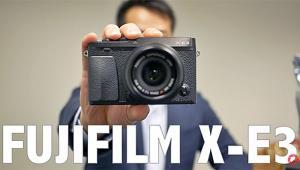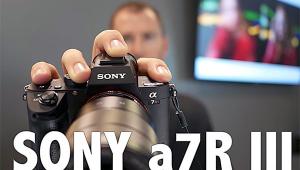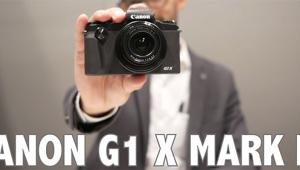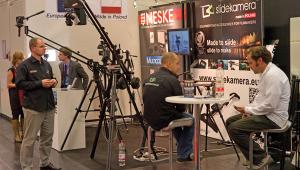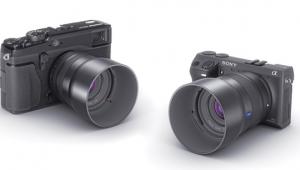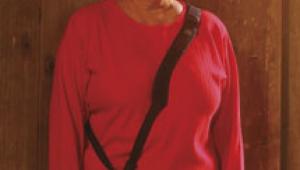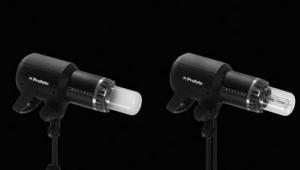Digital SLRs “Digital-Dedicated” Lenses, Printers, Software... And Some New Films, Too
 The
annual Photo Marketing Association (PMA) Show is the US market's introduction
to new products and services that will be appearing on store shelves and, increasingly,
Internet sales shops in 2005. Coming on the heels of last year's photokina,
the Consumer Electronics Show (CES), and the hoard of other trade shows that
litter the calendar of late, this, the largest of US photo/imaging shows, has
become increasingly hard-pressed to debut anything that wasn't introduced
elsewhere before, or hadn't been rumored for weeks in various chat rooms.
Indeed, manufacturers no longer wait for any trade show to make their big announcements,
and release products based more on buying and competitive cycles than any trade
show's calendar. Nonetheless, these shows do give us an opportunity to
see, touch, and feel products that were only virtual or had only achieved prototype
status beforehand. It also gives us an opportunity to get the best reporters
in the business assembled to give their sage opinions on the state of the industry
today.
The
annual Photo Marketing Association (PMA) Show is the US market's introduction
to new products and services that will be appearing on store shelves and, increasingly,
Internet sales shops in 2005. Coming on the heels of last year's photokina,
the Consumer Electronics Show (CES), and the hoard of other trade shows that
litter the calendar of late, this, the largest of US photo/imaging shows, has
become increasingly hard-pressed to debut anything that wasn't introduced
elsewhere before, or hadn't been rumored for weeks in various chat rooms.
Indeed, manufacturers no longer wait for any trade show to make their big announcements,
and release products based more on buying and competitive cycles than any trade
show's calendar. Nonetheless, these shows do give us an opportunity to
see, touch, and feel products that were only virtual or had only achieved prototype
status beforehand. It also gives us an opportunity to get the best reporters
in the business assembled to give their sage opinions on the state of the industry
today.
Our team included Peter Burian, Joe Farace, Roger Hicks, Frances Schultz, Bob
Mayer, Jack Neubart, and Jon Canfield, with additional support from Chris Maher,
Larry Berman, and Ingrid Krampe. Indeed, a first for us this year was live reports
from the show on our website, www.shutterbug.com, from Jon Canfield, with interviews
being conducted for the Internet Shutterbug Radio Show by Jack Warren. It's
what you might call total coverage by an experienced and intrepid team, and
I salute them for their work.
Why, you might ask, would we pour such effort and resources into covering this
show? First and foremost, we get to talk face to face with manufacturers, R&D
folks, and inventors of new and amazing products. This gives us the opportunity
to get the scoop that otherwise might be difficult to obtain and an inside track
on what's coming in the year and years ahead. We also get to see new gear
that is what the industry calls "under NDA," or Non-Disclosure Agreements.
We often engage in feedback sessions and give our honest opinions about coming
products, plus plan our reviews and reports for coming issues of this magazine.
While I won't steal the thunder of the reports that follow, some items
are certainly worthy of note in this brief introduction. Perhaps the one news
item that brought the most joy to our hearts was the announcement that Ilford
is back and will be "filling the product pipeline" even before this
issue goes to press. There was some panic among black and white film fans and
especially printers about the fate of Ilford, and various business moves seem
to assure that we will still have these great film, paper, and chemical products
available. And speaking of film, both Kodak and Fuji
announced new, or at least upgraded, film products. Interestingly,
one of the developments is a sure nod to the digital age, with Kodak and Fuji
creating film products that they claim are eminently more "scannable"
and "optimized for the digital workflow."
On the camera front we note with some sadness that not one new film SLR was
introduced at the show. When Nikon announced the amazing F6
at photokina (see our website archives, www.shutterbug.com, or the April 2005
issue for the review) we thought that more might follow, but none did, causing
us to wonder about the fate of this category. But digital SLRs were sure there,
although most new models saw their debut previous to the show. The exception
was a new high-speed sports and reportage specialty digital SLR from Nikon and
Canon's update on the EOS Digital Rebel, the XT. As new
models come up rebates on the "older" models are available, and
the price on the previous Rebel has gotten to very affordable levels.
The proliferation of so-called "digital-dedicated" lenses continues,
which in essence means that they are of little use to 35mm film camera users
but provide smaller, faster, and more highly-corrected lenses for digital SLR
fans. The wide zoom range is all the rage, with short focal lengths now being
offered in the 11mm and even 10mm range. Of course, you have to multiply that
by your "lens conversion factor," and we wonder when this shell
game will abate and we can stop worrying about low numbers and actually talk
in terms of angle of view. On the digicam front the 8-megapixel models seem
to be undergoing the big fade, with 7 megapixels being the current darlings.
We did see some amazing software solutions, chief among them being the RawShooter
Essentials freebie available from Pixmantec through the Corel
website (www.corel.com),
for now. The company is making this available to seed the market for upgrades
to come, but we tried it and we're impressed. Rumors about Photoshop CS2
were all around the show floor and it has been released by now, and we have
a preview from Joe Farace in this issue. We also saw some amazing fix-it-up
software from DxO Labs, including a lighting and noise solution
that is right on the mark.
Ink jet printing keeps getting better, and both Epson and HP
came to this show with some dazzling systems. With eight and now nine inks we're
promised more neutral monochrome printing and more vivid and true-to-life color.
Indeed, one of the NDAs I mentioned was with Epson who, when we go to press,
will be revealing an entirely new approach to black and white that will turn
our previous workflow on its head.
So, I hope you enjoy our coverage of the products and services unveiled at this
year's PMA. While there were few blockbusters, there was surely enough
to keep all our reporters hustling around the show floor and our reports filled
with new gear.
- Log in or register to post comments
